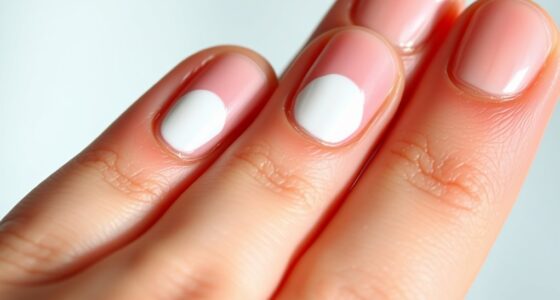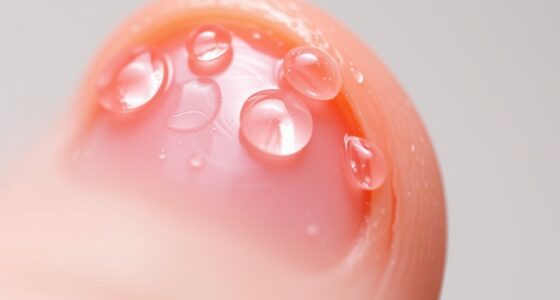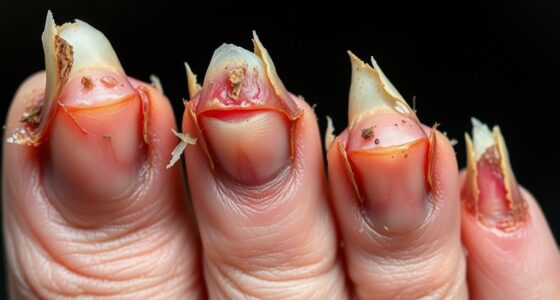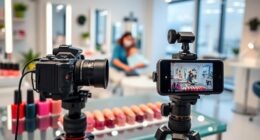When you cure UV gel polish, the nail lamp emits specific wavelengths of UV or LED light that activate photoinitiators in the gel. These chemicals produce free radicals that kick-start polymerization, transforming liquid monomers and oligomers into a tough, glossy film. This process guarantees a durable finish that resists cracks and peel-offs. To understand how different lamps and factors influence this process, keep exploring the science behind nail curing.
Key Takeaways
- UV gel polish cures through polymerization triggered by UV light activating photoinitiators in the formula.
- Photoinitiators produce free radicals that link monomers and oligomers into a solid, glossy film.
- Proper wavelength and intensity of UV light are essential for complete, durable curing of the gel.
- UV lamps emit a broad spectrum, enabling deeper curing and richer color activation.
- Safety considerations include minimizing skin exposure and optimizing curing conditions for best results.
Understanding the Composition of UV Gel Polish
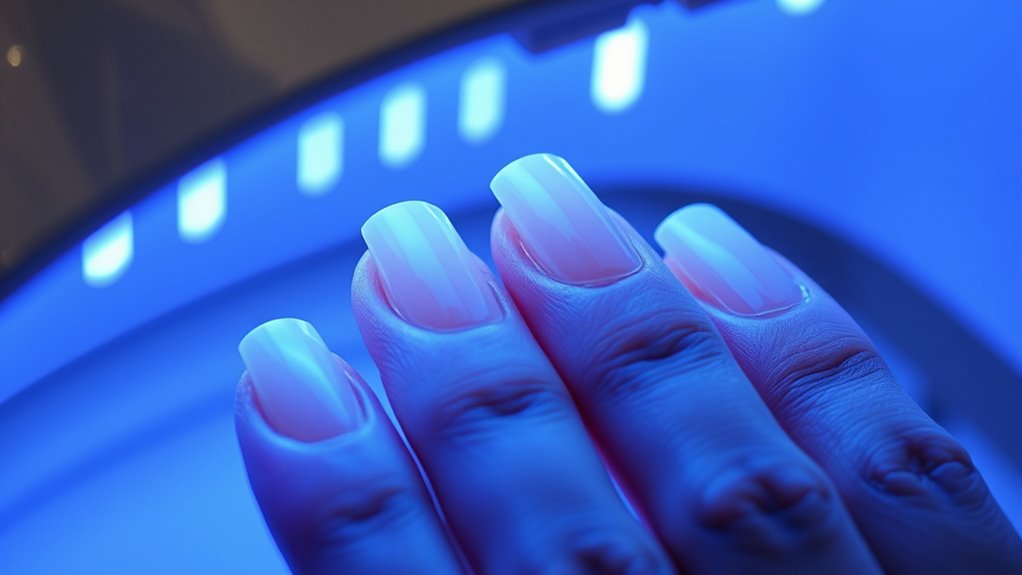
To understand how UV gel polish works, it’s essential to know what it’s made of. The key components include monomers and oligomers, which create a durable, flexible film. These ingredients are designed for high UV stability, allowing the polish to cure effectively under UV light. Gel adhesion is critical, so the formula includes adhesion promoters that help the gel stick firmly to your nail surface. The polish’s composition ensures it remains stable during application and curing, preventing cracks or peel-offs. When you apply UV gel polish, its chemical makeup allows it to react with UV light, initiating polymerization. This process transforms the liquid gel into a solid, long-lasting coating that enhances your nails’ appearance and durability. Understanding the chemistry behind these components helps explain why UV gel polish provides such a resilient finish.
The Role of Light in the Curing Process

The light used during curing needs to match specific wavelengths to activate the gel effectively. If the light isn’t intense enough, the gel won’t fully harden, leading to a weak finish. Understanding how wavelength and light strength impact curing helps you achieve a smooth, durable manicure. Proper automation technology in nail lamps ensures consistent and effective curing results.
Wavelength Specificity
Have you ever wondered how UV gel polish hardens so quickly and effectively? It all comes down to wavelength specificity. Nail lamps emit specific wavelengths of UV light that match the chemical bonds in gel polish, triggering the curing process. This precision guarantees the gel hardens uniformly, making nail art look flawless. When salon equipment is designed with the right wavelength, the curing process is efficient and reliable. Different gel formulas respond best to certain wavelengths, so understanding this helps nail technicians optimize results. If the light isn’t targeted correctly, curing can be incomplete, leading to weaker nails or chipped polish. Wavelength specificity is key to achieving a durable, glossy finish that lasts. Additionally, the light spectrum used in UV lamps is carefully calibrated to ensure consistent curing performance. It’s the science behind fast, effective nail art that keeps your clients coming back.
Light Intensity Impact
Wavelength specificity guarantees that UV gel polish cures at the correct chemical bonds, but the intensity of the light also plays a vital role in the process. Higher UV intensity increases curing efficiency, allowing the gel to harden more quickly and thoroughly. If the light isn’t intense enough, the curing process slows, leading to a weaker finish and potential chipping. Conversely, excessively high UV intensity can cause overheating, damaging your nails or skin. Ideal curing requires a balanced UV intensity tailored to your gel polish’s specifications. Proper light intensity ensures you achieve a smooth, durable finish without prolonging the process or risking damage. Understanding this impact helps you choose the right lamp and settings for efficient, safe curing every time.
How Nail Lamps Emit UV and LED Light

When you turn on a nail lamp, it emits either UV or LED light to cure your gel polish. These lights produce specific wavelengths that activate the curing process. Understanding how UV and LED lamps generate different wavelengths helps explain how they effectively harden gel nails. Projector bulb maintenance tips can also apply to managing the longevity of UV and LED light sources in nail lamps.
UV and LED Emission
Nail lamps emit UV and LED light through specialized bulbs or diodes designed to produce specific wavelengths that activate gel polish. These wavelengths are carefully calibrated to initiate the curing process effectively, guaranteeing your gel hardens properly. By emitting targeted light, they help improve nail polish longevity, making your manicure last longer without chipping. Additionally, the precise emission reduces unnecessary exposure, enhancing customer safety by minimizing potential risks associated with broader-spectrum light. LED lamps generally emit visible light with minimal UV radiation, while UV lamps produce a broader spectrum, but both are designed to optimize curing efficiency. This focused emission ensures your gel polish cures thoroughly, giving you a durable finish while prioritizing safety during each session. Wavelengths are a crucial factor in ensuring the efficiency and safety of the curing process.
Light Wavelengths Explained
Nail lamps produce their curing power through specific wavelengths of UV and LED light, which directly influence how effectively your gel polish hardens. These wavelengths determine how well the polish’s pigments activate, impacting color vibrancy and overall appearance. UV lamps typically emit a broader spectrum of light, allowing for deeper curing and enhanced color richness. LED lamps emit a more focused wavelength, offering faster curing times. Understanding these wavelengths helps you choose the right lamp for your needs, ensuring ideal results. Properly matched wavelengths improve the gel’s adhesion, which boosts longevity enhancement. By selecting the appropriate light spectrum, you can achieve brighter, more vibrant nails that last longer, reducing chipping and peeling. In short, the specific light wavelengths are vital for achieving a flawless, durable gel manicure. On-device AI capabilities are increasingly being integrated into nail technology, opening up new possibilities for customization and efficiency.
Photoinitiators and Polymerization: The Chemistry at Work
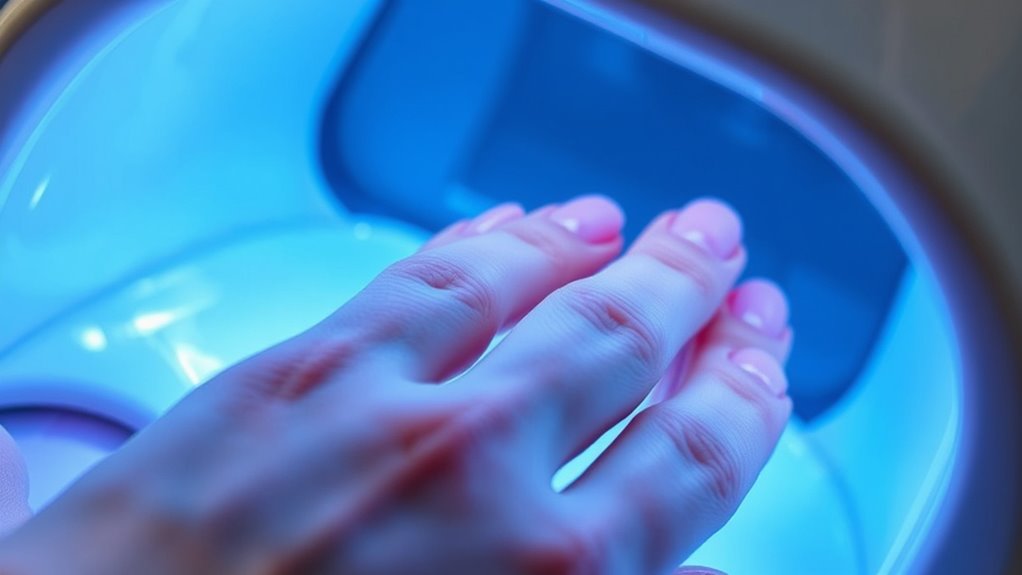
Photoinitiators are the key agents that trigger the curing process in UV gel polish, converting light energy into chemical reactions. When exposed to UV light, photoinitiator activation occurs, generating free radicals that jump-start the polymer chain reaction. These radicals attack the monomers and oligomers in the gel, linking them together into a solid, hardened structure. This polymerization process transforms the liquid gel into a durable, glossy coating. Without effective photoinitiators, the gel wouldn’t cure properly, leaving it soft or tacky. The efficiency of this process depends on how well the photoinitiators absorb UV light and produce radicals. By understanding the chemistry at work, you can appreciate how the light initiates a rapid, controlled chain reaction that results in a flawless, long-lasting manicure.
Differences Between UV and LED Nail Lamps
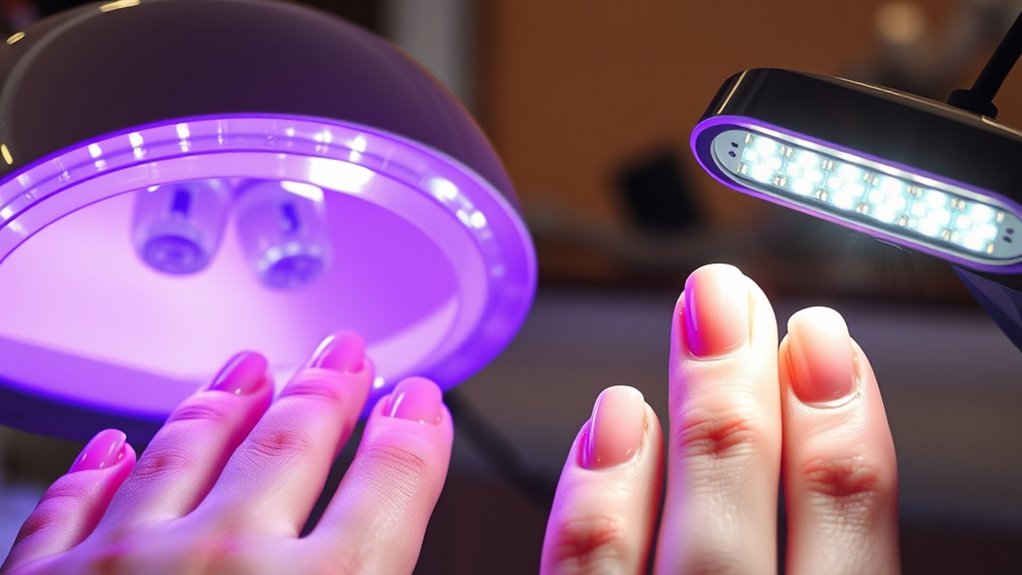
While both UV and LED nail lamps serve the same purpose of curing gel polish, they operate through different mechanisms that affect curing time, efficiency, and lamp lifespan. UV lamps emit broad-spectrum UV light, which can cure gels more slowly and may require longer exposure. LED lamps, on the other hand, emit specific wavelengths that target photoinitiators more efficiently, leading to faster curing. This impacts:
- Nail polish longevity, as proper curing ensures longer-lasting results.
- Safety considerations, since UV exposure carries potential risks over time.
- Energy consumption, with LED lamps typically being more energy-efficient.
- Lamp lifespan, as LED bulbs tend to last much longer than traditional UV bulbs.
- Proper curing techniques and understanding the importance of correct exposure can significantly influence results and safety.
Understanding these differences helps you choose the right lamp for reliable, safe, and durable gel manicures.
Factors Affecting the Curing Time and Finish
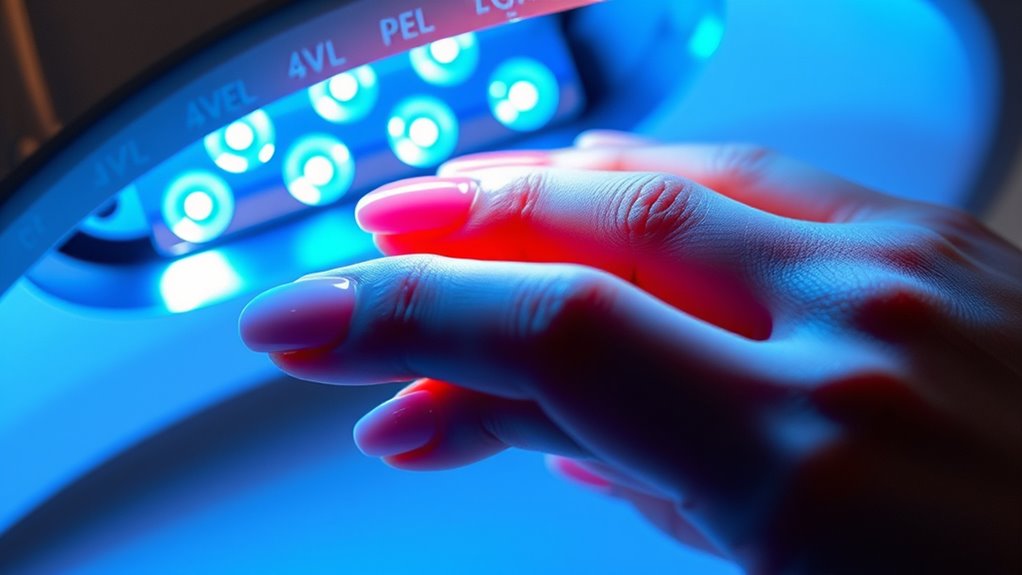
The effectiveness of gel polish curing depends on several key factors that influence both the curing time and the final finish. Environmental factors, like ambient temperature and humidity, can slow down or accelerate the curing process, affecting how well the polish hardens. High humidity may cause tackiness or uneven curing, while cooler temperatures can extend curing times. Nail quality also plays a vital role; healthy, well-prepared nails ensure better adhesion and uniform curing. Weak or damaged nails may lead to uneven finish or premature chipping. Properly prepping your nails, including cleaning and buffing, helps optimize curing. Using the right type of UV or LED lamp ensures efficient curing and a smooth finish. Understanding these factors allows you to adjust your technique and environment, guaranteeing a faster, more durable, and flawless gel polish finish.
Innovations and Future Developments in Nail Curing Technology
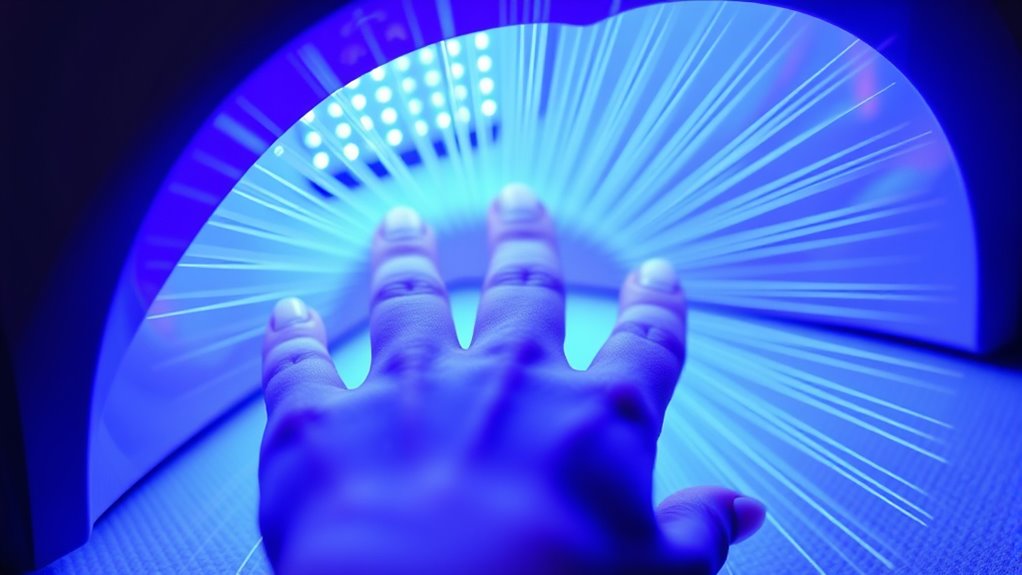
These innovations also emphasize effective design principles, ensuring that devices are user-friendly and ergonomically optimized.
These developments aim to optimize performance while prioritizing user safety, making gel manicures more effective and accessible.
Frequently Asked Questions
How Long Does UV Gel Polish Typically Last Before Chipping?
UV gel polish typically lasts about two to three weeks before chipping, depending on durability factors like your daily activities and nail care. To extend its lifespan, follow maintenance tips such as avoiding harsh chemicals, wearing gloves during chores, and applying a top coat every few days. Proper preparation and care help prevent chipping, ensuring your manicure stays fresh and vibrant for the maximum duration.
Are UV or LED Lamps Safer for Skin Exposure?
You might wonder if UV or LED lamps are safer for skin exposure. LED lamps generally pose fewer UV safety concerns because they emit less harmful UV rays and cure gel faster, reducing exposure time. While both types are considered safe when used properly, LED risks are lower, making them a better choice for skin safety. Always follow manufacturer instructions to minimize UV exposure and protect your skin.
Can UV Gel Polish Damage Natural Nails?
UV gel polish can potentially cause chemical damage if used improperly or too frequently, but it generally doesn’t harm your natural nails when applied correctly. You might notice thinning or brittleness if you neglect proper nail health routines. To protect your nails, make sure your nails are well-conditioned, avoid excessive buffing, and give your nails regular breaks from gel polish. Proper application and care minimize risks and keep your nails healthy.
What Causes Bubbles or Uneven Curing During Application?
You might see bubbles or uneven curing because of air bubble formation during application or improper curing factors. Air bubbles often happen when you don’t apply the gel smoothly or shake the bottle vigorously, trapping air. Uneven curing can result from inconsistent lamp distance, low-quality bulbs, or insufficient curing time. To avoid these issues, apply thin, even layers and follow the recommended curing instructions carefully to guarantee a smooth, flawless finish.
How Do Different Brands of Gel Polish Vary in Curing Time?
Did you know that curing times can differ by up to 30% among gel polish brands? You’ll find that some brands are compatible with specific nail lamps, impacting curing speed. Variations in formula thickness and pigment density influence curing speed differences, so it’s essential to choose a brand that matches your lamp for ideal results. Testing different brands helps you find the perfect match for quick, even curing every time.
Conclusion
Now that you know the science behind nail lamps, you can confidently choose and use your UV or LED gel polish. Understanding the unique nuances of curing times, light types, and chemistry helps you achieve flawless, lasting finishes. By blending beauty with biology, you’ll be better equipped to embrace innovations and enjoy impeccable manicures. So, stay savvy, stay stylish, and let science support your spectacular self-care sessions!


